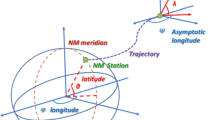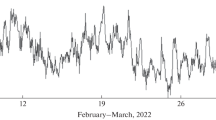Abstract
For over 60 years, neutron monitors have remained the main standard, stable instrument for the measurement of cosmic rays with energies from 400 MeV to hundreds of GeV. In order to obtain sufficiently complete information about the distribution of cosmic rays outside the magnetosphere, it is necessary to have a network of detectors that are fairly evenly spaced around the globe. One of the most useful methods to obtain the properties of the angular distribution of cosmic rays without decomposition into harmonics is the ring of station method. It allows one to obtain the instantaneous (more precisely, hourly) longitudinal distribution of the intensity of cosmic rays without its modeling. The main goal of this work is to expand the use of the ring of station method, a convenient and useful method for the study of cosmic ray variations.



Similar content being viewed by others
REFERENCES
Abunina, M.A., Belov, A.V., Eroshenko, E.A., Abunin, A.A., Oleneva, V.A., Yanke, V.G., and Melkumyan, A.A., The ring of station method in research of cosmic ray variations: 2. Applications, Geomagn. Aeron. (Engl. Transl.), 2020, vol. 60, no. 2.
Belov, A.V., Bieber, J.W., Eroshenko, E.A., Evenson, P., Pyle, R., and Yanke, V.G., Pitch-angle features in cosmic rays in advance of severe magnetic storms: Neutron monitor observations, Proc. 27th ICRC, Hamburg: Germany, 2001, pp. 3507–3510.
Belov, A., Baisultanova, L., Eroshenko, E., Mavromichalaki, H., Yanke, V., Pchelkin, V., Plainaki, C., and Mariatos, G., Magnetospheric effects in cosmic rays during the unique magnetic storm on November 2003, J. Geophys. Res., 2005a, vol. 110, A09S20. https://doi.org/10.1029/2005JA011067
Belov, A., Eroshenko, E., Mavromichalaki, H., Plainaki, C., and Yanke, V., Solar cosmic rays during the extremely high ground level enhancement on 23 February 1956, Ann. Geophys., 2005b, vol. 23, no. 6, pp. 2281–2291.
Belov, A., Abunin, A., Abunina, M., Eroshenko, E., Oleneva, V., Yanke, V., Papaioannou, A., and Mavromichalaki, H., Galactic cosmic ray density variations in magnetic clouds, Sol. Phys., 2015, vol. 290, no. 5, pp. 1429–1444.
Belov, A., Eroshenko, E., Yanke, V., Oleneva, V.A., Abunin, A.A., and Abunina, M.A., Global survey method for the world network of neutron monitors, Geomagn. Aeron. (Engl. Transl.), 2018a, vol. 58, no. 3, pp. 356–372.
Belov, A., Eroshenko, E., Yanke, V., Oleneva, V., Abunin, A., Abunina, M., Papaioannou, A., and Mavromichalaki, H., The global survey method applied to ground-level cosmic ray measurements, Sol. Phys., 2018b, vol. 293, no. 4, id 68.
Gvozdevsky, B., Belov, A., Eroshenko, E., Yanke, V., Gushchina, R., and Ptuskin, V., Geomagnetic cutoff rigidities of cosmic rays and their secular changes, Proc. 42nd COSPAR Scientific Assembly, Pasadena: Calif., 2018, id D1.2-31-18.
Hatton, C.J. and Carmichael, H., Experimental investigation of the NM-64 neutron monitor, Can. J. Phys., 1964, vol. 42, pp. 2443–2472.
Korotkov, V., Berkova, M., Belov, A., Eroshenko, E., Yanke, V., and Pyle, R., Procedure to emend neutron monitor data that are affected by snow accumulations on and around the detector housing, J. Geophys. Res.: Space, 2013, vol. 118, no. 11, pp. 6852–6857.
Krymskii, G.F., Altukhov, A.M., Kuz’min, A.I., and Skripin, G.V., Novyi metod issledovaniya anizotropii kosmicheskikh luchei. Issledovanie po geomagnetizmu i aeronomii (New Method for Studying the Anisotropy of Cosmic Rays. Research on Geomagnetism and Aeronomy), Moscow: Nauka, 1966.
Krymskii, G.F., Kuz’min, A.I., Krivoshapkin, P.A., Samsonov, I.S., Skripin, G.V., Transkii, I.A., and Chirkov, N.P., Kosmicheskie luchi i solnechnyi veter (Cosmic Rays and Solar Wind), Novosibirsk: Nauka, 1981.
Kuwabara, T., Bieber, J.W., Clem, J., et al., Real-time cosmic ray monitoring system for space weather, Space Weather, 2006, vol. 4, S08001. https://doi.org/10.1029/2005SW000204
Moraal, H., Belov, A., and Clem, J., Design and co-ordination of multi-station international neutron monitor network, Space Sci. Rev., 2000, vol. 93, pp. 285–303.
Parsons, N., Effects of short-term world-wide modulation of the primary cosmic radiation on observed daily intensity variations, J. Geophys. Res., 1960, vol. 65, no. 10, pp. 3159–3161.
Shea, M.A. and Smart, D.F., A five by fifteen degree world grid of calculated cosmic ray vertical cutoff rigidities for 1965 and 1975, Proc. 14th ICRC, München: Germany, 1975, vol. 4, pp. 1298–1303.
Shea, M.A., Smart, D.F., Humble, J.E., Fluckiger, E.O., Gentile, L.C., and Nichol, M.R., A revised standard format for cosmic ray ground-level event data, Proc. 20th ICRC, Moscow: 1987, vol. 3, pp. 171–174.
Simpson, J.A., Cosmic-radiation neutron intensity monitor, Ann. Int. Geophys. Year, 1957, vol. 4, pp. 351–373.
4. ACKNOWLEDGMENTS
The authors are grateful to the teams of the world network of CR stations providing data for the continuous recording of the neutron component: (http://cr0.izmiran.ru/ ThankYou/Our_Acknowledgment.pdf); Thanks to the NMDB database (www.nmdb.eu). The work is based on experimental data from the United Nations University (UNU) Russian National Cosmic Ray Station Network.
Funding
This work was partly supported by the Basic Research Program of the Presidium of the Russian Academy of Sciences (no. 3); the Russian Foundation for Basic Research (project no. 17-02-00508), and the Russian Science Foundation (grant no. 15-12-20001).
Author information
Authors and Affiliations
Corresponding authors
Rights and permissions
About this article
Cite this article
Abunina, M.A., Belov, A.V., Eroshenko, E.A. et al. Ring of Station Method in Research of Cosmic Ray Variations: 1. General Description. Geomagn. Aeron. 60, 38–45 (2020). https://doi.org/10.1134/S0016793220010028
Received:
Revised:
Accepted:
Published:
Issue Date:
DOI: https://doi.org/10.1134/S0016793220010028




